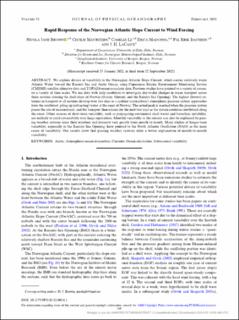| dc.description.abstract | We explore drivers of variability in the Norwegian Atlantic Slope Current, which carries relatively warm Atlantic Water toward the Barents Sea and Arctic Ocean, using Copernicus Marine Environment Monitoring Service (CMEMS) satellite altimetry data and TOPAZ4 ocean reanalysis data. Previous studies have pointed to a variety of causes, on a variety of time scales. We use data with daily resolution to investigate day-to-day changes in ocean transport across three sections crossing the shelf-slope of Norway (Svinøy, Gimsøy, and the Barents Sea Opening). The highest (lowest) extremes in transport at all sections develop over two days as a cyclonic (anticyclonic) atmospheric pressure system approaches from the southwest, piling up (extracting) water at the coast of Norway. The actual peak is reached when the pressure system passes the site of measurement, and the transport then relaxes for the next two days as the system continues northward along the coast. Other sources of short-term variability, such as propagating continental shelf waves and baroclinic instability, are unlikely to yield covariability over large separations. Monthly variability in the current can also be explained by passing weather systems since their numbers and intensity vary greatly from month to month. Many studies of longer-term variability, especially in the Barents Sea Opening, have pointed to the North Atlantic Oscillation (NAO) as the main cause of variability. Our results show that passing weather systems offer a better explanation of month-to-month variability. | en_US |
